Top News
November 22 2012 Ryukyu Shimpo
The Military Base Affairs Division of the Okinawa Prefectural Government has reported to the Ministry of Foreign Affairs of Japan that one of the military personnel based at Futenma Air Station has deserted. It would seem that this person has not yet been apprehended.
According to the division, the U.S. military confirmed on November 9 that the person had deserted and U.S. Forces Japan (UFJ) reported this to the ministry on November 16. The Governors’ Association for Military Facilities in Japan reported this to the Okinawa Prefectural Government on November 20, and the prefectural government informed the relevant municipal governments the following day.
In an attempt to implement preventive measures, UFJ placed a curfew on all their military personnel in Japan following the alleged rape of a woman by two U.S. sailors in October. However, in November, a heavily intoxicated airman broke into an apartment and punched a teenage boy in Yomitan, and a U.S. Marine Corps lieutenant trespassed in a room of a building in Naha. These incidents, and this case of desertion could make Okinawan people further criticize the ineffectiveness of the U.S. military’s preventive measures and their enforcement of the law to stop a recurrence of such incidents.
(English translation by T&CT, Mark Ealey)
Go to Japanese

November 24, 2012 Ryukyu Shimpo
To help commemorate the 120th anniversary of the establishment of the Ryukyu Shimpo the Kinoshita Circus will begin performances in Okinawa from December 1 at a special venue set up in Toyosaki Town in Tomigusuku City. Some of the circus staff arrived in Okinawa on November 23, and about 100 of the circus troupe worked up a sweat as they set up the tent site in preparation for the show.
After leaving Ariake Port in Tokyo on the evening of November 20, part of the troupe arrived at Naha Port more than two days later, at around 4:00pm, on November 22. The circus transported many animals to Okinawa, including 11 lions (including four white lions), one giraffe, two elephants, and two pony horses. The giraffe was transported in a six meter-high container, allowing the animal to assume a natural posture with its neck fully extended.
At the venue in Tomigusuku, the animals seemed relaxed after their long voyage. John Illig, whose career as a lion trainer goes back 35 years said, “I want people to come to see the purebred white lions. There are now only 300 of these in the world.”
Tadashi Kinoshita, the president of the circus, told, “We performed in Okinawa eight years ago, but I want many people to enjoy this new-generation circus. The performance has changed in many ways from the last time we were here.”
From December 1 until February 3, 2013, the Kinoshita Circus will showcase its animals, a flying trapeze and many other performances.
For further information, telephone the desk for the Kinoshita Circus in the Ryukyu Shimpo, 098 869 5311.
Go to Japanese

Go To Video
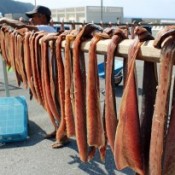
November 18, 2012 Ryukyu Shimpo
At the Ginama Fishing Port in Kunigami, work has begun to sun-dry funuyu or dolphin fish, which are popular in winter. On November 16, curtains of fleshy dolphin fish were hung out in the early winter sunlight.
October to December is the season to catch dolphin fish, but fishermen say that so far this year is a lean year. After catching the fish, fishermen filet their catch into three pieces, rub salt into them, and put them out to dry in the sun for two days. Usually the sun-dried fish are all pre-sold, but when there is a particularly good catch they are also able to be purchased directly from the fishermen. Sixty-three year-old fisherman Yoshikazu Chinen, who was hanging the fillets out, said, “Traditionally, it is said that a lucky person catches a lot of these fish. We have not caught many this year, so we need to catch more.”
(English translation by T&CT, Megumi Chibana and Mark Ealey)
Go to Japanese

November 19, 2012 Ryukyu Shimpo
On November 18, the award ceremony for the Fish 1 Grand Prix was held at the sea park in Itoman. It is an event held as part of the Festa 2012 aimed at creating a rich sea off Okinawa. The Mizumi Co., located in Nanjo won the Grand Prix among a total of 26 exhibitors with a seika (diamond squid) sausage. It was selected through a combination of voting by visitors, a review by a panel of judges, and an evaluation of sales performance.
The Grand Prix winner is able to secure support from the Okinawa Prefectural Government to expand its products to markets in other prefectures. The company is to participate in business meetings in Tokyo and Osaka to sell its goods, aiming to make its debut nationwide as a new specialty of Okinawa. Kumiko Uechi, of Mizumi Co., was overjoyed, saying, “I am very confident about this item. I want to sell our products outside Okinawa, and winning this award is the first step towards achieving that goal.
According to the organizers, in the two days it was held a total of about 52000 people including family groups visited the venue thanks to the fine weather on November 18, the last day of the event, following indifferent weather on the opening day.
(English translation by T&CT, Mark Ealey)
Go to Japanese
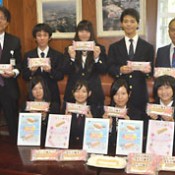
November 12, 2012 Ryukyu Shimpo
On November 7, Urasoe Technical High School and major convenience store Lawson Okinawa announced that they have developed a product called Sakutto Time, a snack food product using taro.
They started selling it on November 13 in all Lawson stores in Okinawa and in five San-A shopping centers in Urasoe. The price for one is 130 yen, including tax, and only 34000 will be produced.
Ongoing collaborative development of products by Okinawan high schools and Lawson Okinawa started in 2009. The aim is to motivate students to participate in society and to give them opportunities to show their learning outcomes.
Sakutto Time uses piecrust with taro paste. The students also inserted pale pink whipped cream inside to represent the popular row of cherry trees in their school.
Third year cooking course student Shoya Komesu, said, “I would like people to try it during snack time when they are relaxing.” Misa Ueyama, a third year design student, created the packaging and said that she was satisfied with what her hard work has produced and hopes that the product sells out.
(English translation by T&CT, Lima Tokumori and Mark Ealey)
Go to Japanese

November 17, 2012 Ryukyu Shimpo
On November 16, the Council for Cultural Affairs recommended that Education Minister Makiko Tanaka formally designate the Yabiji coral reef community of Miyako-jima as a place of scenic beauty, and the tsunami stones of the east coast of Ishigaki-jima as a natural treasure. A total of 97 such locations in Okinawa are designated as either historical sites, places of scenic beauty, or natural monuments.
Extending for 17 kilometers from north to south and 6.5 kilometers from east to west, Yabiji is the largest coral reef community in Japan. It is located between five to 22 kilometers to the north of Ikema-jima in the Miyako-jima district. This will be the first time that a natural coral reef community is designated as a place of scenic beauty. A representative of the council rates it very highly in terms of its academic and aesthetic value, stating, “It is one of the key coral reef communities that make the coast of the Ryukyu Islands what it is, and it is also the largest in Japan.”
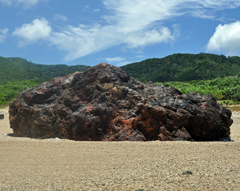
On Ishigaki-jima, tsunami stones on the east coast of the island are to be designated as a national nature treasure. (Photograph provided by the Ishigaki-jima Education Board).
The tsunami stones consist of four stones that were scattered as a result of two tidal bores: one in 1771, and another that occurred about 2000 years ago. It is the first time that such tsunami stones, that specifically highlight the threat of tsunami, will be designated as a national nature treasure. A spokesperson for the council stated, “The stones are valuable in that they remind Japan, a country in an area that frequently experiences earthquake, of the threat of tsunami.”
The council recommended that the Ministry of Education, Culture, Sports, Science and Technology newly designate 17 locations, including two from Okinawa, and additionally designate 19 locations as historic sites, places of scenic beauty, or as natural monuments. The council also recommended that the ministry add three new locations to the registered monuments of Japan, newly selecting one and adding another to the important cultural landscape. Those nominated will be notified soon.
(English translation by T&CT, Mark Ealey)
Go to Japanese
November 17, 2012 Ryukyu Shimpo
Following the recent crimes committed by U.S. military personnel, including the member of the United States Army Air Force who trespassed and then assaulted a teenage boy, the Okinawa Prefectural Assembly held a special meeting on November 16 in which it unanimously adopted a resolution and a formal written statement of opinion. The resolution states that the assembly will lodge a protest against the incidents, demanding an apology and seeking full compensation for victims from the U.S. military forces, as well as requesting the handing over of the suspects. The assembly is scheduled to conduct protest activities on November 19.
In the resolution, the assembly pointed out that measures such as strengthening discipline following the alleged rape of a woman in the central region of the main island of Okinawa by two U.S. military personnel are only temporary and are designed to placate Okinawan people’s anger, and that the recent incidents proved that these measures have no real effect.
On that basis, the assembly concluded that the only way to protect lives and human rights of Okinawan people is to consolidate and scale down the size of the U.S. military bases in Okinawa and to place a curfew on all their military personnel. The resolution also requests a fundamental review of the Japan-U.S. Status-of-Forces Agreement, and that the curfew on all U.S. military personnel in Okinawa be strictly enforced. Furthermore, the assembly decided to demand that the U.S. military forces consolidate and scale down the bases in Okinawa.
The assembly intends to send the resolution to five representatives including the U.S. Ambassador to Japan and the Okinawa Area Coordinator, and the formal written opinion to four key figures such as the Prime Minister and Foreign Minister.
(English translation by T&CT, Mark Ealey)
Go to Japanese
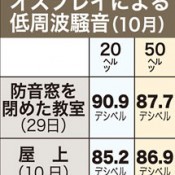
November 16, 2012 Kenta Masuda of Ryukyu Shimpo
On October 29, Takeshi Tokashiki, an associate professor of the University of the Ryukyus, conducted a low-frequency sound measurement survey in No. 2 Futenma Elementary School when the MV-22 Osprey transport aircraft took off from U.S. Marine Corps Air Station Futenma in Ginowan. According to the survey, a 90.9 dB low-frequency sound was measured at 20 Hz in a closed classroom fitted with soundproof windows. This exceeded the measurement taken on the roof of the school building on a different day.
The Ministry of Defense has installed the best quality soundproofing insulation in the school, but questions are being raised about its effectiveness because the characteristic noise generated by the Osprey aircraft was recorded in the room.
According to the Ministry of the Environment, the low-frequency noise spectrum is in the range of 1-100 Hz, which creates a feeling of pressure, discomfort and shakes furniture. The Ministry of Defense organizes the noise insulation work, which is carried out with gradations of effectiveness from 1 to 4. While the government requires an average noise reduction of more than 35 dB at 125-4000 Hz, in the provisions for Grade 1 there is no provision for mitigation of low-frequency sound.
The team led by the associate professor carried out the low-frequency sound survey at nine steps from 12.5 Hz to 80 Hz on the roof of the school building on October 10 and in the classroom on October 29, when the Osprey took off in helicopter-mode using the same flight path.
In particular, the maximum value of the low-frequency sound was confirmed at 20 Hz. While 85.2 dB were recorded on the roof at 1:31pm, on October 10, 90.9 dB were measured in the closed room at 19:06pm, on October 29.
These figures are greater than the 80 dB at 20 Hz, which is the threshold value for physical impact stated in the environmental impact assessment that the Okinawa Defense Bureau created as part of the Henoko relocation plan for U.S. Marine Corps Futenma Air Station.
In its decision on the Futenma roar lawsuit in 2010, for the first time the appeal court recognized the causal relationship between low-frequency sound and mental and physical damage. On November 7, in the Cabinet Committee of the House of Representatives, Chief Cabinet Secretary Osamu Fujimura commented, “If necessary, the government will continue to conduct scientific investigations on noise.” However, the government does not carry out low-frequency sound measurements.
Residents of the Ojana and Kakazu districts of Ginowan complained that since the Osprey has been deployed chairs tremble when there is a deep bass sound, and that dishes have fallen off shelves.
Tokashiki said, “The building is made of concrete, but the low-frequency sound enters the rooms through the aluminum sash windows. The problem will not be solved unless the government provides adequate sound proofing measures.”
(English translation by T&CT, Mark Ealey)
Go to
Japanese
November 20, 2012 Ryukyu Shimpo
The 24 year-old U.S. Marine Corps lieutenant based at Camp Foster and suspected of trespassing in a room of a building in Naha on November 18, initially denied the charges during police questioning after his arrest, claiming that a Japanese woman he met at a club told him to take a rest there. However, the police reported on November 19 that the suspect subsequently admitted the charges, and stated that it was a mistake for him to make such an assertion. The suspect acknowledged that despite knowing about the 11:00pm to 5:00am curfew placed on all U.S. troops in Japan he had been out drinking during these hours, so it turns out that the suspect violated the curfew and committed the crime. On the same day, Naha Police handed over the man to the Naha District Public Prosecutors’ Office on suspicion of trespassing. The incident clearly indicates that the curfew has little meaning.
According to the police, the suspect said that it was an embarrassment for him to have caused the incident and that he was sorry to have scared the person in the apartment. The suspect said that he was too drunk to remember anything, but wished to apologize.
The suspect said that he drank alone at three establishments in Naha during the period from around 8:30pm on November 17 to 6:00am on November 18, thereby violating the curfew.
According to the police, the suspect said that he had acquaintance who worked at the first place he went to, and that he had occasionally gone there in the past.
It would seem that the suspect went out of Futenma Air Station to drink at some of his favorite bars and restaurants, but the police intend to continue seeking further evidence.
The suspect has been stationed in Okinawa since last July, and currently belongs to the Marine Wing Communications Squadron 18 of Camp Foster. The nature of his mission was not disclosed, but he resides in Futenma Air Station. Although the Naha Police initially reported that the suspect works at Futenma Air Station, this was corrected on November 19, when they stated that the U.S. military supplied mistaken information.
(English translation by T&CT, Mark Ealey)
Go to Japanese

November 12, 2012 Ryukyu Shimpo
Seven youth volunteers visited Yona and Kunigami from Japan and abroad. On November 6, they made amidaki (bamboo fences) and participated in mowing the grass on roads, harvesting crops, and community sports festival with the local residents of Yona and Kunigami.
Mikiko Yasui from Osaka and Natsue Yoshida from Kanagawa participated in the volunteer program called Inaka-de-Hatarakitai (I want to work in the country) and will stay from this September until March 2013.
Mikiko Yasui said, “Local people bring food and other things to me. It makes me happy and I feel that they are pleased with what we do.”
On November 1, five volunteers from the International Work Camp by NPO NICE in Tokyo participated in a sports festival for elderly women and helped to pick mandarin oranges for two weeks.
Oscal Carbasse from Switzerland commented, “The place is really beautiful and quite distinct from Tokyo.”
Because the number of young people is decreasing, the Yunamun dakuma community group founded by the head of the Tsuha district is striving to revitalize the Yona community.
Group member Yasushi Oshiro is hoping that these youth volunteers will contribute to this. He said, “We want the residents of Yona to be proud of their community by experiencing local activities with young volunteers from all over the world.”
Inaka-de-Hatarakitai is a program coordinated by the Ministry of Agriculture, Forestry and Fisheries to encourage the movement of manpower from big cities to rural regions in order to secure and develop human resources in agricultural regions.
NPO NICE, Never-ending International work Camps Exchange is undertaking the program for the ministry.
(English translation by T&CT, Hitomi Shinzato and Mark Ealey)
Go to Japanese

November 12, 2012 Sadao Tome Correspondent of Ryukyu Shimpo
Takane Kochihira, an Okinawan sanshin player, songwriter and Okinawan cultural coordinator, has given live performances on the west coast of the United States. In a 10-day period, Kochihira performed at places such as Japanese-American senior citizens’ homes and at the Okinawa Association of America. Kochihira took with him a special sanshin featuring a minsah pattern, a traditional Okinawan textile, because the one he uses in Japan is a Yaeyamakuruchi, a top-of-the-line sanshin rarely available for purchase, and he did not want to damage it during his trip. Kochihira was very happy to have performed in the United States for the first time. Many young people have enjoyed his live performances.
Kochihira was born in Shuri, but both his parents are from Miyako-jima. He learned to play the sanshin from his grandfather when he was a child. When his relatives gathered during the New Year’s Holidays, Kochihira would always play the sanshin as an accompaniment to the kachashi dance, which always pleased his grandmother. She would give him 5000 yen in addition to New Year’s pocket-money. Kochihira later wrote a song entitled Oba No Uta (A Song for Grandma), devoted to her being strict but at the same time kind.
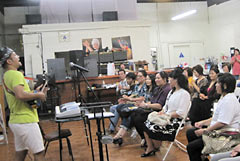
The audience enjoyed Kochihira's performance in the Okinawa Association of America’s Yamauchi Building.
Kochihira moved to Tokyo when he was 20 years old. While working part-time, he wrote and composed songs, and gave live performances in schools and taverns.
When talking about his life in Tokyo, Kochihira said that if you have a good head on your shoulders, you will be capable of making a living wherever you go. He wrote a song entitled Torch of Teada, and has performed live in a total of 47 prefectures. In his shows, he played his own songs such as Nuchido Takara, Umuiuta and You and I walk on Route 58 along with Okinawan popular songs, and has always received a favorable reception.
Kochihira lives with his wife, who is from Kanagawa Prefecture, and their daughter in the Zushi district of Kanagawa. Kochihira said, “Although my family tomb is back in Okinawa, I want to work outside Okinawa to get the people of the main islands of Japan, and of the outside world, to know more about our prefecture. I’m also planning to give some shows in South America.” Kochihira came back to Japan after performing in Las Vegas, but next year he plans to perform in Hawaii and South American countries including Peru.
(English translation by T&CT, Mark Ealey)
Go to Japanese











 Webcam(Kokusai Street)
Webcam(Kokusai Street)


